Akizuki-class destroyer (1942)
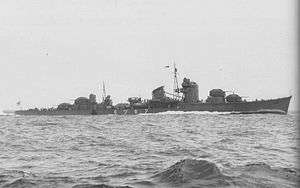 Akizuki on trial run off Miyazu Bay on 17 May 1942. | |
| Class overview | |
|---|---|
| Name: | Akizuki class |
| Builders: | |
| Operators: | |
| Subclasses: |
|
| Cost: |
|
| Built: | 1940–1945 |
| In commission: | 1942–1945 (IJN) |
| Planned: | 6 (1939) + 10 (1941) + 23 (1942) |
| Completed: | 12 |
| Cancelled: | 27 |
| Lost: | 6 |
| Retired: | 6 |
| General characteristics (as per Whitley[1]) | |
| Type: | Destroyer |
| Displacement: |
|
| Length: | 134.2 m (440 ft 3 in) overall |
| Beam: | 11.6 m (38 ft 1 in) |
| Draught: | 4.15 m (13 ft 7 in) |
| Propulsion: |
|
| Speed: | 33 knots (38 mph; 61 km/h) |
| Range: | 8,000 nmi (15,000 km) at 18 kn (21 mph; 33 km/h) |
| Complement: |
|
| Armament: |
|
The Akizuki-class destroyers (秋月型駆逐艦 Akizuki-gata Kuchikukan) were one of the primary classes of new destroyers of the Imperial Japanese Navy (IJN) after 1942. The IJN called them Type-B Destroyer (乙型駆逐艦, Otsu-gata Kuchikukan) from their plan name. They were designed to fight smaller ships, aircraft and submarines.
This is considered to have been the most useful class of destroyers Japan fielded during the war and was well regarded in the IJN.[1] They mounted 3.9-inch (100mm) Type 98 dual-purpose guns in four twin mounts. They also were among the first Japanese vessels equipped with radar. The ships were lighter in their torpedo armament than most contemporary Japanese destroyers, which typically had a heavy emphasis on offensive torpedo armament, most classes having two 4-tube centerline launchers capable of firing to either side, with quick-reloads for both launchers. The Akizuki class had only a single four tube launcher, plus reloads, but the ships compensated with stronger anti-aircraft armament, having four turrets as opposed to three, with guns firing shells of smaller caliber but greater velocity, and therefore effectiveness.
Ships of the Fuyutsuki and Michitsuki subclasses were modified to simplify and speed-up construction.
Four ships were used for war reparation.
Ships in classes
Akizuki class
Project number F51. General production type of the Akizuki class. Seven vessels were built under the Maru 4 Programme (Ship # 104-109) and the Maru Kyū Programme (Ship # 360).
| Ship # | Ship | Builder | Laid down | Launched | Completed | Fate |
| 104 | Akizuki (秋月) | Maizuru Naval Arsenal | 30 June 1940 | 2 July 1941 | 11 June 1942 | Sunk during the Battle of Cape Engaño on 25 October 1944. Removed from naval ship list on 10 December 1944. |
| 105 | Teruzuki (照月) | Mitsubishi, Nagasaki Shipyard | 13 November 1940 | 21 November 1941 | 31 August 1942 | Heavily damaged by USS PT-37 and PT-40 off Savo Island on 11 December 1942. Scuttled on 12 December 1942. Removed from naval ship list on 20 January 1943. |
| 106 | Suzutsuki (涼月) | Mitsubishi, Nagasaki Shipyard | 15 March 1941 | 3 March 1942 | 29 December 1942 | Survived war at Sasebo. Decommissioned on 20 November 1945. Converted to breakwater at Kitakyūshū in July 1948. |
| 107 | Hatsuzuki (初月) | Maizuru Naval Arsenal | 25 July 1941 | 3 April 1942 | 29 December 1942 | Sunk during the Battle of Cape Engaño on 25 October 1944. Removed from naval ship list on 10 December 1944. |
| 108 | Niizuki (新月) | Mitsubishi, Nagasaki Shipyard | 8 December 1941 | 29 June 1942 | 31 March 1943 | Sunk during the Battle of Kula Gulf on 6 July 1943. Removed from naval ship list on 10 September 1943. |
| 109 | Wakatsuki (若月) | Mitsubishi, Nagasaki Shipyard | 9 March 1942 | 24 November 1942 | 31 May 1943 | Sunk during the Battle of Ormoc Bay on 11 November 1944. Removed from naval ship list on 10 January 1945. |
| 360 | Shimotsuki (霜月) | Mitsubishi, Nagasaki Shipyard | 6 July 1942 | 7 April 1943 | 31 March 1944 | Sunk by USS Cavalla off Anambas Islands 02°21′N 107°20′E / 2.350°N 107.333°E on 25 November 1944. Removed from naval ship list on 10 January 1945. |
Fuyutsuki class
Project number F51. The Fuyutsuki subclass were originally going to be built to the same specifications as the Akizuki class but construction was more simplified. Four vessels were built under the Maru Kyū Programme (Ship # 361-364). Main differences from the Akizuki class were simplified bow design, removed rear deck house, and fitted two-dimensional air inlet for boilers. However, the IJN was not satisfied with the design. More modifications were ordered, leading to the Michitsuki subclass.
| Ship # | Ship | Builder | Laid down | Launched | Completed | Fate |
| 361 | Fuyutsuki[4][5] (冬月) | Maizuru Naval Arsenal | 8 May 1943 | 20 January 1944 | 25 May 1944 | Survived war at Kitakyūshū. Decommissioned on 20 November 1945. Converted to breakwater at Kitakyūshū in July 1948. |
| 362 | Harutsuki (春月) | Sasebo Naval Arsenal | 23 December 1943 | 3 August 1944 | 28 December 1944 | Survived war at Kure. Decommissioned on 5 October 1945. Surrendered to Soviet Union on 28 August 1947 and renamed Vnezapniy (Внезапный, lit. "sudden"). |
| 363 | Yoizuki (宵月) | Uraga Dock Company | 25 August 1943 | 25 September 1944 | 31 January 1945 | Survived war at Nōmi. Decommissioned on 5 October 1945. Surrendered to Republic of China on 29 August 1947 and renamed Fen Yang. Scrapped in 1963. |
| 364 | Natsuzuki (夏月) | Sasebo Naval Arsenal | 1 May 1944 | 2 December 1944 | 8 April 1945 | Survived war at Kitakyūshū. Decommissioned on 5 October 1945. Surrendered to United Kingdom on 25 August 1947. Sold and scrapped at Uraga in September 1947-March 1948. |
Michitsuki class
Project number F53. Final production model of the Akizuki class. Simplified more than Fuyutsuki class. Converted 5 vessels from the Maru Kyū Programme (Ship # 365-369) and 16 vessels from the Maru 5 Programme (Ship #770-785 were re-planned to #5061-5076). However, only 1 vessel was completed.
| Ship # | Ship | Builder | Laid down | Launched | Completed | Fate |
| 365 | Michitsuki[6][7] (満月) | Sasebo Naval Arsenal | 3 January 1945 | 16% complete, construction stopped on 17 April 1945. Scrapped on 28 February 1948. | ||
| 366 | Hanazuki (花月) | Maizuru Naval Arsenal | 10 February 1944 | 10 October 1944 | 26 December 1944 | Survived war at western Inland Sea. Decommissioned on 5 October 1945. Surrendered to United States on 29 August 1947 and renamed DD-934. Sunk as target off the Gotō Islands on 3 February 1948.[8] |
| 367 | Kiyotsuki (清月) | Maizuru Naval Arsenal | Cancelled on 14 December 1944. | |||
| 368 | Ōtsuki (大月) | Sasebo Naval Arsenal | ||||
| 369 | Hazuki (葉月) | Maizuru Naval Arsenal | ||||
| 5061 5062 5063 5064 5065 |
Yamazuki (山月) Urazuki (浦月) Aogumo (青雲) Benigumo (紅雲) Harugumo (春雲) |
|||||
| 5066 5067 5068 5069 5070 5071 5072 5073 5074 5075 5076 |
Amagumo (天雲) Yaegumo (八重雲) Fuyugumo (冬雲) Yukigumo (雪雲) Okitsukaze (沖津風) Shimokaze (霜風) Asagochi (朝東風) Ōkaze (大風) Kochi (東風) Nishikaze (西風) Hae (南風) |
Cancelled on 9 June 1944. |
Super Akizuki class
Project number V7. High-speed model of the Akizuki class. Only a project. 16 vessels were planned under the Maru 5 Programme (Ship # 770-785) and 7 vessels were converted from Super Shimakaze class under the Kai-Maru 5 Programme (Ship #733-748 were re-planned to #5077-5083).
| Ship # | Ship | Builder | Laid down | Launched | Completed | Fate |
| 770-785 | Converted to Akizuki class (later Michitsuki class, Ship # 5061-5076) on 30 June 1942. | |||||
| 5077-5083 | Kitakaze (北風) Hayakaze (早風) Natsukaze (夏風) Fuyukaze (冬風) Hatsunatsu (初夏) Hatsuaki (初秋) Hayaharu (早春) |
Cancelled on 9 June 1944. |
Photos
-
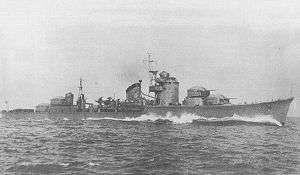
Hatsuzuki trial run in December 1942.
-

Fuyutsuki trial run on 23 May 1944.
-
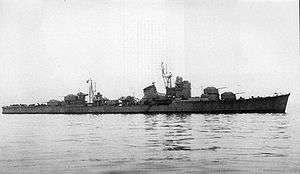
Harutsuki trial run in December 1944.
-
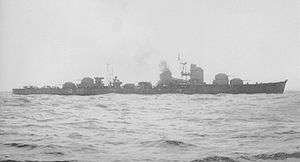
Hanazuki on 18 December 1944.
-
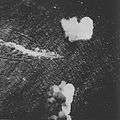
Akizuki off Empress Augusta Bay on 29 September 1942.
-

Carrier Zuikaku and four Akizuki-class (Akizuki, Hatsuzuki, Wakatsuki and Shimotsuki) during the Battle of the Philippine Sea on 20 June 1944.
-
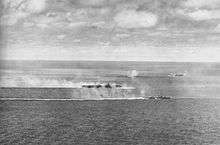
Carrier Zuikaku, Zuihō and destroyer Wakatsuki during the Battle of Cape Engaño on 25 October 1944.
-

Destroyer Akizuki, Kuwa and battleship Ise during the Battle of Cape Engaño on 25 October 1944.
-
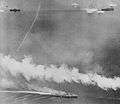
Wakatsuki during the Battle of Ormoc Bay on 11 November 1944.
-

Battleship Yamato and Fuyutsuki during the Operation Ten-Go on 7 April 1945.
-

Suzutsuki during the Operation Ten-Go on 7 April 1945.
-

Yoizuki as repatriation transport in 1946.
-

Michitsuki in May 1947.
-

ROCS Fen Yang (ex-Yoizuki).
See also
References
- 1 2 Whitley, M J (2000). Destroyers of World War Two: An International Encyclopedia. London: Arms and Armour Press. p. 204. ISBN 1-85409-521-8.
- ↑ "Rekishi Gunzō"., History of the Pacific War Vol.23 Akizuki class destroyer, Gakken (Japan), 1999, ISBN 4-05-602063-9
- ↑ The Maru Special, Japanese Naval Vessels No.19 Destroyer Asashio class/Akizuki class, Ushio Shobō (Japan), 1978, Book code 8343-7
- ↑ 1 October 1943, Administrative order No. 235, Named one destroyer, two submarines, one coast defence ship, two minesweepers, and one submarine chaser., Minister's Secretariat, Ministry of the Navy.
- ↑ National Archives of Japan, Reference code: C12070120400, October (1) p.1.
- ↑ 5 February 1945, Administrative order No. 22, Named four destroyers, one submarine, and six coast defence ships., Minister's Secretariat, Ministry of the Navy.
- ↑ National Archives of Japan, Reference code: C12070510100, February (1) p.44.
- ↑ Pike, John (27 April 2005). "globalsecurity.org". Archived from the original on 19 November 2007. Retrieved 23 November 2007.
- "Japan Center for Asian Historical Records"., National Archives of Japan.
- Reference code: C12070120400, October (1).
- Reference code: C12070510100, February (1).
- USN Navsource
External links
| Wikimedia Commons has media related to Akizuki class destroyers (1942). |
- CombinedFleet.com: Akizuki-class destroyers
- IJN Akitsuki Class Destroyers, Globalsecurity.org
